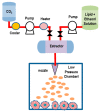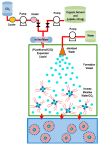Methods of Liposomes Preparation: Formation and Control Factors of Versatile Nanocarriers for Biomedical and Nanomedicine Application
- PMID: 35335920
- PMCID: PMC8955843
- DOI: 10.3390/pharmaceutics14030543
Methods of Liposomes Preparation: Formation and Control Factors of Versatile Nanocarriers for Biomedical and Nanomedicine Application
Abstract
Liposomes are nano-sized spherical vesicles composed of an aqueous core surrounded by one (or more) phospholipid bilayer shells. Owing to their high biocompatibility, chemical composition variability, and ease of preparation, as well as their large variety of structural properties, liposomes have been employed in a large variety of nanomedicine and biomedical applications, including nanocarriers for drug delivery, in nutraceutical fields, for immunoassays, clinical diagnostics, tissue engineering, and theranostics formulations. Particularly important is the role of liposomes in drug-delivery applications, as they improve the performance of the encapsulated drugs, reducing side effects and toxicity by enhancing its in vitro- and in vivo-controlled delivery and activity. These applications stimulated a great effort for the scale-up of the formation processes in view of suitable industrial development. Despite the improvements of conventional approaches and the development of novel routes of liposome preparation, their intrinsic sensitivity to mechanical and chemical actions is responsible for some critical issues connected with a limited colloidal stability and reduced entrapment efficiency of cargo molecules. This article analyzes the main features of the formation and fabrication techniques of liposome nanocarriers, with a special focus on the structure, parameters, and the critical factors that influence the development of a suitable and stable formulation. Recent developments and new methods for liposome preparation are also discussed, with the objective of updating the reader and providing future directions for research and development.
Keywords: drug delivery; lipid-based nanocarriers; liposome formation; nanomedicine; phospholipids self-assembly.
Conflict of interest statement
The authors declare no conflict of interest.
Figures



















Similar articles
-
Advancements in liposomal formulations: A comprehensive exploration of industrial production techniques.Int J Pharm. 2024 Jun 10;658:124212. doi: 10.1016/j.ijpharm.2024.124212. Epub 2024 May 8. Int J Pharm. 2024. PMID: 38723730 Review.
-
Constant pressure-controlled extrusion method for the preparation of Nano-sized lipid vesicles.J Vis Exp. 2012 Jun 22;(64):4151. doi: 10.3791/4151. J Vis Exp. 2012. PMID: 22760481 Free PMC article.
-
Novel methods for liposome preparation.Chem Phys Lipids. 2014 Jan;177:8-18. doi: 10.1016/j.chemphyslip.2013.10.011. Epub 2013 Nov 9. Chem Phys Lipids. 2014. PMID: 24220497 Review.
-
Design of multifunctional liposome-quantum dot hybrid nanocarriers and their biomedical application.J Drug Target. 2017 Sep;25(8):661-672. doi: 10.1080/1061186X.2017.1323334. Epub 2017 May 8. J Drug Target. 2017. PMID: 28438041 Review.
-
Soft Interaction in Liposome Nanocarriers for Therapeutic Drug Delivery.Nanomaterials (Basel). 2016 Jun 25;6(7):125. doi: 10.3390/nano6070125. Nanomaterials (Basel). 2016. PMID: 28335253 Free PMC article. Review.
Cited by
-
Physical Properties of Cellulose Derivative-Based Edible Films Elaborated with Liposomes Encapsulating Grape Seed Tannins.Antioxidants (Basel). 2024 Aug 14;13(8):989. doi: 10.3390/antiox13080989. Antioxidants (Basel). 2024. PMID: 39199233 Free PMC article.
-
A novel strategy for partial purification of alkane hydroxylase from P. chrysogenum SNP5 through reconstituting its native membrane into liposome.Sci Rep. 2024 Feb 15;14(1):3779. doi: 10.1038/s41598-024-54074-0. Sci Rep. 2024. PMID: 38360875 Free PMC article.
-
Nanoparticle Synthesis and Their Integration into Polymer-Based Fibers for Biomedical Applications.Biomedicines. 2023 Jun 29;11(7):1862. doi: 10.3390/biomedicines11071862. Biomedicines. 2023. PMID: 37509502 Free PMC article. Review.
-
Lipid-Based Nanocarriers for Delivery of Neuroprotective Kynurenic Acid: Preparation, Characterization, and BBB Transport.Int J Mol Sci. 2023 Sep 18;24(18):14251. doi: 10.3390/ijms241814251. Int J Mol Sci. 2023. PMID: 37762551 Free PMC article.
-
Genome Engineering as a Therapeutic Approach in Cancer Therapy: A Comprehensive Review.Adv Genet (Hoboken). 2024 Feb 5;5(1):2300201. doi: 10.1002/ggn2.202300201. eCollection 2024 Mar. Adv Genet (Hoboken). 2024. PMID: 38465225 Free PMC article. Review.
References
Publication types
LinkOut - more resources
Full Text Sources
Other Literature Sources

